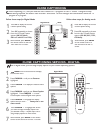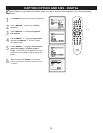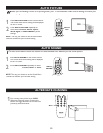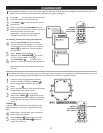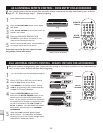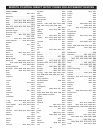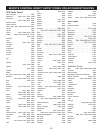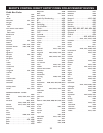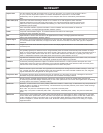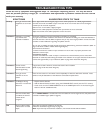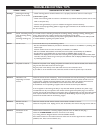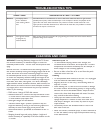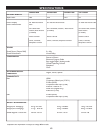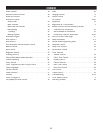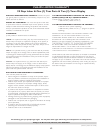
36
GLOSSARY
Aspect Ratio
The ratio between the width and height of the TV picture on the screen. In a normal TV set the aspect ratio is 4
to 3 (4:3). The new aspect ratio in HDTV is 16:9 which resembles the aspect ratio in a movie theatre
(Widescreen). New TV systems support both 4:3 and 16:9 aspect ratio and can automatically switch between
them.
Audio Video (A/V)
A term often used when discussing a channel on a TV receiver or on video equipment, which has been
especially designed to accept VCR audio-video signals. This channel automatically activates special circuitry
within the TV set to prevent picture distortion and skewing. It is also used for audio-video processors, which
handle both types of signals.
ATSC
ATSC: Advanced Television Systems Committee. Formed to establish technical standards for advanced
television systems, including digital high definition television (HDTV).
CVBS
Composite Video Baseband Signal. In broadcast television this refers to the video signal,
including the colour information and syncs
DTV
Digital television. Generic term that refers to all digital television formats, including high-definition television
(HDTV) and standard-definition television (SDTV).
DOLBY Digital
Dolby Digital - Six-channel digital audio standard that is part of the U.S. digital television standard; also called AC-3 or Digital
5.1. The channels consist of front left, front right, front center, surround or rear left, surround or rear right, and a separate
subwoofer
Digital Tuner
A digital tuner serves as the decoder required to receive and display digital broadcasts. It can be included inside TV sets or
via a set-top box.
HDTV
The generally agreed upon definition of HDTV is approximately twice the vertical and horizontal picture resolution of today’s
NTSC TV, which essentially makes the picture twice as sharp. HDTV also has a screen ratio of 16:9 as compared with most of
today’s TV screens, which have a screen ratio of 4:3. HDTV offers reduced motion artifacts (i.e. ghosting, dot crawl), and
offers 5.1 independent channels of CD-quality stereo surround sound, (also referred to as AC-3).
HDMI
High-Definition Multimedia Interface. USB-like digital video connectivity standard designed as a successor to DVI; can transmit
both uncompressed digital audio and video signals; protected by HDCP digital copy protection.
Letterbox
A method of presenting widescreen images on a standard screen television. In order to preserve the aspect ratio of the
original video content, the picture is scaled down so that it fits the available width of the television screen. Since the picture
will not fill the screen vertically, dark bars are displayed above and below the picture.
NTSC
National television system committee. The organization that developed the analog television standard currently in use in the
U.S., Canada, and Japan. Now generally used to refer to that standard. The NTSC standard combines blue, red, and green
signals modulated as an AM signal with an FM signal for audio.
Progressive Scan
In Progressive Scanning all the horizontal scan lines are scanned on to the screen at one time. The Digital TV and HDTV
Standards accept both Interlaced Scan and Progressive Scan broadcast and display methods.
PIP
Picture-In-Picture. A digitally based method of inserting one video image into another for special effects purposes and
for monitoring several video images simultaneously on one screen (several PIP units can be used together each compressing
an image into the main screen in a different location).
Resolution
Resolution: A measurement of the finest (smallest) detail that is visible in a video image. TV Resolutions may be expressed as
number of pixels in an image; or more commonly, “As Total Number of (horizontally scanned) Lines used to create the image.
Standard Digital TV Resolutions:
SDTV: 480i - The picture is 740x480 pixels, 480p - The picture is 704x480 pixels.
HDTV: 720p - The picture is 1280x720 pixels, 1080i - The picture is 1920x1080 pixels, 1080p - The picture is 1920x1080
pixels.
Widescreen
A term given to picture displays with a wider aspect ratio than NTSC 4:3. Digital HDTV or SDTV is referred to as “16:9 wide
screen.” Most motion pictures also have a 16:9 wide screen aspect ratio. Most Digital TVs have a screen that is wider than it
is tall (if a Digital TV screen is nine inches high, it’s 16 inches wide.) When watching a show recorded in the wide screen
format on a Digital TV, viewers see more of the movie, while when viewing wide screen format on an analog TV, cropped
edges are evident.



